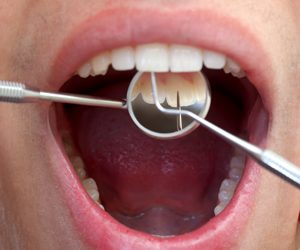 During the course of a day, you’re likely to have a look inside your mouth and briefly survey the landscape. We hope so, anyway. Aside from the stray loose filling or that crown that will need repair soon, fuss over the soft tissues in your mouth—the mucous membrane, the skin. Are there any red or white spots you haven’t noticed before? Maybe you have taken a wait-and-see approach to a small sore you found last week. Any unexplained swelling? Discoloration that doesn’t hurt a lick? Come on in; we need to see what you see.
During the course of a day, you’re likely to have a look inside your mouth and briefly survey the landscape. We hope so, anyway. Aside from the stray loose filling or that crown that will need repair soon, fuss over the soft tissues in your mouth—the mucous membrane, the skin. Are there any red or white spots you haven’t noticed before? Maybe you have taken a wait-and-see approach to a small sore you found last week. Any unexplained swelling? Discoloration that doesn’t hurt a lick? Come on in; we need to see what you see.
Most oral lesions, as we call them, are harmless. A piece of crusty French bread with dinner can scratch delicate tissues. But if you use tobacco and alcohol, or are being treated for any number of systemic diseases—diabetes, autoimmune disorders among them—that harmless irritation is a red flag. During your dental appointment, we’ll take a closer look. When we find a lesion, suspicious or not, we intend to err on the cautious side.
Think about this…
- You are the proud owner of a mouth. It generally starts out fairly healthy. Bleeding gums DO NOT come with the territory.
- There’s a fungus among us. Candidiasis—an infection manifested by white patches on the tongue or mucosal surfaces—are the bane of denture wearers. This affliction can be painful but treatable.
- Ulcers where? Iron deficiency can cause oral ulcers, or for some women, recur once a month during menstruation. They hurt too, but are quite treatable.
- Is your tongue a bother? Have the dentist investigate an unnaturally smooth tongue that’s likely bright red. Anemia or vitamin deficiency may be involved.
Change is not always good, nor bad. The idea is to alert the dentist to changes that get your attention and go check it out. So help take an active role in your health remember to remain vigilant about changes in your mouth.
